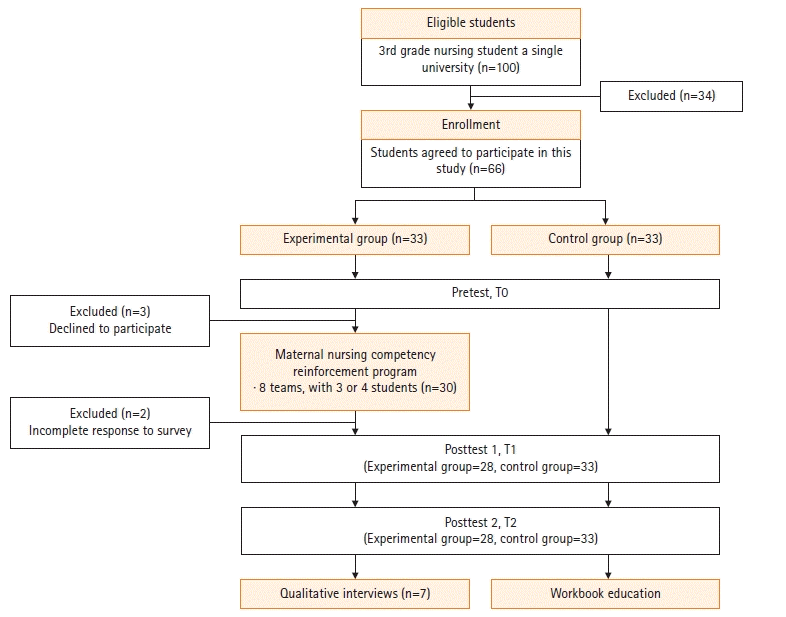|
1 |
Introduction of program |
• Greetings, introduction |
• Building rapport |
30 |
|
• Introducing the program’s goals and operating methods |
• Motivating for learning |
|
• Guiding to learning management |
|
2 |
Preview |
Homework |
• Facilitating self-directed learning |
60 |
|
• Watching the video about core major nursing skill |
|
3 |
Uterine involution scenario |
1) Understanding the scenario |
• Elicit participants to know how to assess maternal uterine involution and postpartum lochia. |
10 |
|
• Understanding the symptoms of uterine involution and postpartum lochia, assessing the condition |
• Promote participants to understand and empathize with the maternal physical and psychological state. |
|
• Empathize with the maternal psychological state when insufficiency of uterine involution |
• Encourage participants themselves to derive nursing problems that may arise with uterine involution and postpartum lochia. |
|
• Thinking about problem-focused solutions |
• Elicit participants to learn the rationale for uterine involution and postpartum lochia. |
|
2) Practice clinical skills |
• Demonstrate nursing performance that meets the patient’s nursing needs |
60 |
|
• Observing the demonstration |
• Observe and feedback 1:1 training |
|
• 1:1 skill training |
• Promote positive reinforcement |
|
3) Debriefing |
• Elicit reflection and internalization. |
50 |
|
Rupture of Membrane scenario |
1) Understanding the scenario |
• Elicit participants to know how to assess amniotic membrane rupture |
10 |
|
• Assessing amniotic membrane rupture |
• Promote participants to understand and empathize with the maternal physical and psychological state. |
|
• Empathize with the maternal psychological state in case of amniotic membrane rupture or premature amniotic membrane rupture |
• Encourage participants themselves to derive nursing problems that may arise with amniotic membrane rupture. |
|
• Thinking about problem-focused solutions |
• Elicit participants to learn the rationale for amniotic membrane rupture, nitrazine test, and AmniSure® test |
|
2) Practice clinical skills |
• Demonstrate nursing performance that meets the patient’s nursing needs |
60 |
|
• Observing the demonstration |
• Observe and feedback 1:1 training |
|
• 1:1 skill training |
• Promote positive reinforcement |
|
3) Debriefing |
• Elicit reflection and internalization. |
50 |
|
4 |
Delivery process scenario |
1) Understanding the scenario |
• Elicit participants to know how to delivery progress |
10 |
|
• Assessing delivery progress |
• Promote participants to understand and empathize with the maternal physical and psychological state. |
|
• Empathize with the maternal psychological state during the delivery process and vaginal examination |
• Encourage participants themselves to derive nursing problems that may arise with delivery progress. |
|
• Thinking about problem-focused solutions |
• Elicit participants to learn the rationale for delivery process and vaginal examination. |
|
2) Practice clinical skills |
• Demonstrate nursing performance that meets the patient’s nursing needs |
60 |
|
• Observing the demonstration |
• Observe and feedback 1:1 training |
|
• 1:1 skill training |
• Promote positive reinforcement |
|
3) Debriefing |
• Elicit reflection and internalization. |
50 |
|
Induced labor scenario |
1) Understanding the scenario |
• Elicit participants to know how to induced labor |
10 |
|
• Assessing the need for induced labor |
• Promote participants to understand and empathize with the maternal physical and psychological state. |
|
• Empathize with the maternal psychological state during the induced labor |
• Encourage participants themselves to derive nursing problems that may arise with induced labor. |
|
• Thinking about problem-focused solutions |
• Elicit participants to learn the rationale for induced labor. |
|
2) Practice clinical skills |
• Demonstrate nursing performance that meets the patient’s nursing needs |
60 |
|
• Observing the demonstration |
• Observe and feedback 1:1 training |
|
• 1:1 skill training |
• Promote positive reinforcement |
|
3) Debriefing |
• Elicit reflection and internalization. |
50 |
|
5 |
Closing |
• Presentation of impressions of participation |
• Re-promote positive reinforcement |
10 |
|
• Distribution of certificate finish |
|
• Greetings |
|
• A total of eight teams, with three or four students on each team (Each team learns two maternal nursing competencies per day) |
580 |
|
• A 2-day course (a total of four maternity nursing competencies) |




 PDF
PDF Citation
Citation Print
Print




 XML Download
XML Download